
Scorpions are predatory arachnids of the order Scorpiones. They have eight legs and are easily recognized by a pair of grasping pincers and a narrow, segmented tail, often carried in a characteristic forward curve over the back and always ending with a stinger. The evolutionary history of scorpions goes back 435 million years. They mainly live in deserts but have adapted to a wide range of environmental conditions, and can be found on all continents except Antarctica. There are over 2,500 described species, with 22 extant (living) families recognized to date. Their taxonomy is being revised to account for 21st-century genomic studies.

The subphylum Chelicerata constitutes one of the major subdivisions of the phylum Arthropoda. Chelicerates include the sea spiders, horseshoe crabs, and arachnids, as well as a number of extinct lineages, such as the eurypterids and chasmataspidids.

Solifugae is an order of arachnids known variously as solifuges, sun spiders, camel spiders, and wind scorpions. The order includes more than 1,000 described species in about 147 genera. Despite the common names, they are neither true scorpions nor true spiders. Because of this, it's less ambiguous to call them "solifuges". Most species of solifuge live in dry climates and feed opportunistically on ground-dwelling arthropods and other small animals. The largest species grow to a length of 12–15 cm (5–6 in), including legs. A number of urban legends exaggerate the size and speed of solifuges, and their potential danger to humans, which is negligible.
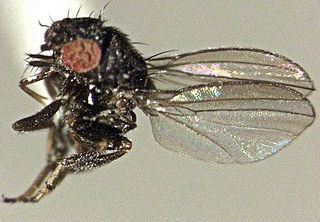
Milichiidae are a family of flies. Most species are very small and dark. Details of their biology have not yet been properly studied, but they are best known as kleptoparasites of predatory invertebrates, and accordingly are commonly known as freeloader flies or jackal flies. However, because of the conditions under which many species breed out, they also are known as filth flies.
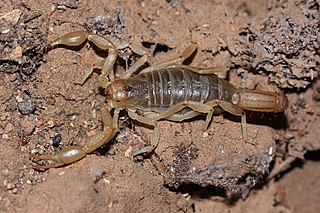
Paravaejovis spinigerus, commonly known as the stripe-tailed scorpion or devil scorpion, is a species of scorpion in the family Vaejovidae. It is found in the south-western United States and north-western Mexico.

Spiders are air-breathing arthropods that have eight limbs, chelicerae with fangs generally able to inject venom, and spinnerets that extrude silk. They are the largest order of arachnids and rank seventh in total species diversity among all orders of organisms. Spiders are found worldwide on every continent except Antarctica, and have become established in nearly every land habitat. As of September 2024, 52,309 spider species in 134 families have been recorded by taxonomists. However, there has been debate among scientists about how families should be classified, with over 20 different classifications proposed since 1900.

Paruroctonus boreus, commonly known as the northern scorpion, is a species of scorpion in the family Vaejovidae. It is the northernmost species of scorpion, the only scorpion found in Canada, and one of the scorpions with the broadest distribution over North America.
Vaejovis brysoni is a species of scorpions belonging to the family Vaejovidae discovered in 2013 in the Santa Catalina Mountains of southern Arizona. It was reportedly discovered in an area that overlooks the city of Tucson by Robert W. Bryson Jr., after whom the species is named. At the date of its discovery it became the tenth species of mountain scorpion known to occur in Arizona, and the second in the vorhiesi group to inhabit the specific mountain range.
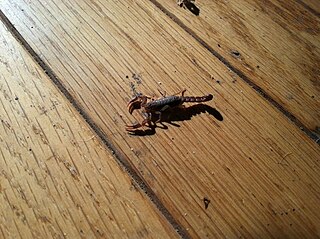
Vaejovis is a genus of scorpions.

Hypochilus thorelli is a species of spider in the family Hypochilidae. Unlike almost all other araneomorph or "true" spiders, members of the family have four book lungs. They are often called "lampshade spiders" because of the shape of their webs which are usually built underneath ledges or projections. H. thorelli is found in the southern Appalachian Mountains of the eastern United States.

Smeringurus is a small genus of scorpions native to Mexico and the southwestern United States within the family Vaejovidae. It is closely related to the genus Paruroctonus, of which it was formerly considered a subgenus.

Paruroctonus silvestrii, also known as the California common scorpion and the stripe-tailed scorpion, is a species of scorpion in the family Vaejovidae. This species is native to the coastal region of the Californias. The stripe-tailed scorpion can be found in dry areas, where it creates and dwells in burrows.
Plateremaeidae is a family of oribatids in the order Sarcoptiformes. There are about 7 genera and 19 described species in Plateremaeidae.

Cunaxidae is a family of predatory mites in the order Trombidiformes. There are at least 20 genera and 390 described species in Cunaxidae.

Stigmaeidae is a family of prostigmatan mites in the order Trombidiformes. At over 600 species, it is the largest family in superfamily Raphignathoidea. It has a worldwide distribution.
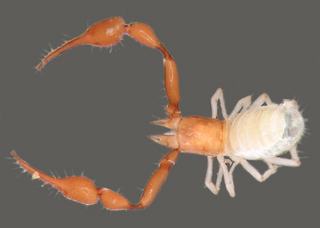
Syarinidae is a family of pseudoscorpions in the order Pseudoscorpiones. There are at least 20 genera and 110 described species in Syarinidae.
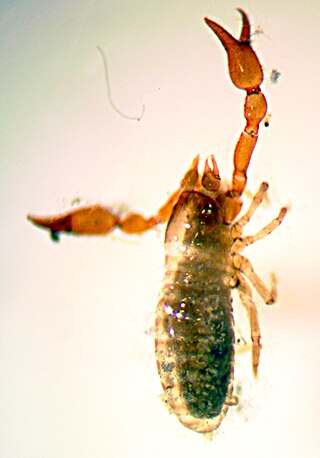
Microbisium parvulum is a species of pseudoscorpion in the family Neobisiidae.

Microbisium is a genus of pseudoscorpions in the family Neobisiidae. There are about 12 described species in Microbisium.

Lusoblothrus is a genus of pseudoscorpions in the family Syarinidae. The genus was created to accommodate its sole species, Lusoblothrus aenigmaticus. The species was recently discovered in Portugal, its description published in 2012.

Petrobia is a genus in Tetranychidae, containing 34 described species. It includes some pest species.

















